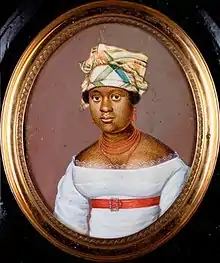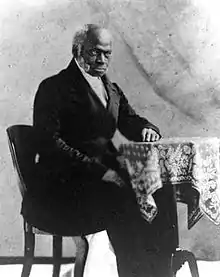Juliette Toussaint
Juliette Noel Toussaint (c. 1786 – May 14, 1851) was a Haitian-American philanthropist and freed slave who collaborated closely with her husband Pierre Toussaint in helping the poor and doing charitable works in downtown New York.[1] Her husband has been declared a Venerable in 1996 by Pope John Paul II.[2]
Juliette Toussaint | |
|---|---|
 Painting by Anthony Meucci (c. 1825) | |
| Laywoman | |
| Born | Marie-Rose Juliette Noel c. 1786 Saint-Domingue (now Haiti) |
| Died | 14 May 1851 (aged 64–65) New York City, United States |
| Venerated in | Roman Catholic Church |
Her name is listed among the donors of the New York African Society for Mutual Relief.[3]
Life
Early life
Little is known about the early life of Juliette. She was born into slavery in the former French colony of Haiti about the year 1786.[4] The Noel family came to Baltimore with their slave owners at some point during the Haitian Revolution. There she labored as a housemaid, assistant cook and nanny.[3]
Marriage and Family

In the wake of the Haitian Revolution, Pierre Toussaint's master went into exile in New York City with him, which granted them the opportunity of meeting one another. Juliette was twenty years younger than him. While still working for her master, Pierre saved enough money to purchase her freedom.[4] In August 5, 1811, they were married privately. For four years they boarded at the house of Pierre's master before settling themselves finally on Franklin Street. Pierre worked on as a hairdresser while Juliette focused on the household needs and availed herself in volunteering for the local church activities.[2][3]
They adopted Euphemia, the daughter of Pierre's late sister Rosalie who had died of tuberculosis, raising the girl as their own. They provided for her education and music classes.
Philanthropy
The couple attended daily masses and began a career of charity among the poor of New York City regardless of color and creed. They often brought baked goods to the children of the Orphan Asylum and donated money to its operations. In their own house, they sheltered and fostered numerous street children, travelers and homeless people.
Together the Toussaints organized a credit bureau, an employment agency, and a refuge for priests. Many Haitian refugees went to them whom they helped in finding jobs. They often arranged sales of goods so they could raise money to live on. With the Oblate Sisters of Providence, they established a school for black children.
They also helped raise money in building a new Roman Catholic church in New York, which became Old St. Patrick's Cathedral on Mott Street. Pierre was a benefactor also of the first New York City Catholic school for Black children at St. Vincent de Paul on Canal Street.[5][3]
Later Years
In May 14, 1851, Juliette died of natural causes. Two years later, Pierre Toussaint died on June 30, 1853. They are buried alongside with Euphemia, in the cemetery of St. Patrick's Old Cathedral.[3]
References
- "Juliette Toussaint". New York Historical Society. 31 May 2008. Retrieved 14 January 2021.
- Deborah Sontag (23 February 1992). ""Canonizing a Slave: Saint or Uncle Tom?"". New York Times. Retrieved 14 January 2021.
- James Sullivan (21 November 2019). "Mary-Noel Juliette Toussaint". Black Past. Retrieved 14 January 2021.
- "Pierre Toussaint". Slavery and Remembrance. Retrieved 14 January 2021.
- "Boniface Hanley, O.F.M." EWTN. Retrieved 14 January 2021.
